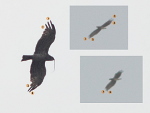 Returning to the important topic of correct identification of differently aged Short-toed Eagles in the nature, Gábor Papp has tried to briefly describe the main characters of juvenile, 2, 3 and 4 cy eagles, and also visual differences between adult males and females. His description are illustrated with the corresponding images. Here is two versions of the text, Hungarian and English ones:
Returning to the important topic of correct identification of differently aged Short-toed Eagles in the nature, Gábor Papp has tried to briefly describe the main characters of juvenile, 2, 3 and 4 cy eagles, and also visual differences between adult males and females. His description are illustrated with the corresponding images. Here is two versions of the text, Hungarian and English ones:
• Gábor PAPP, 2015 – A kígyászölyv kor és ivarhatározása – segédlet a terepi megfigyelések minőségének javításához [Ageing and sexing of the Short-toed Eagle – an aid to improve the quality of field observations in Hungary] // short-toed-eagle.net –  (Hu),
(Hu),  (En).
(En).
